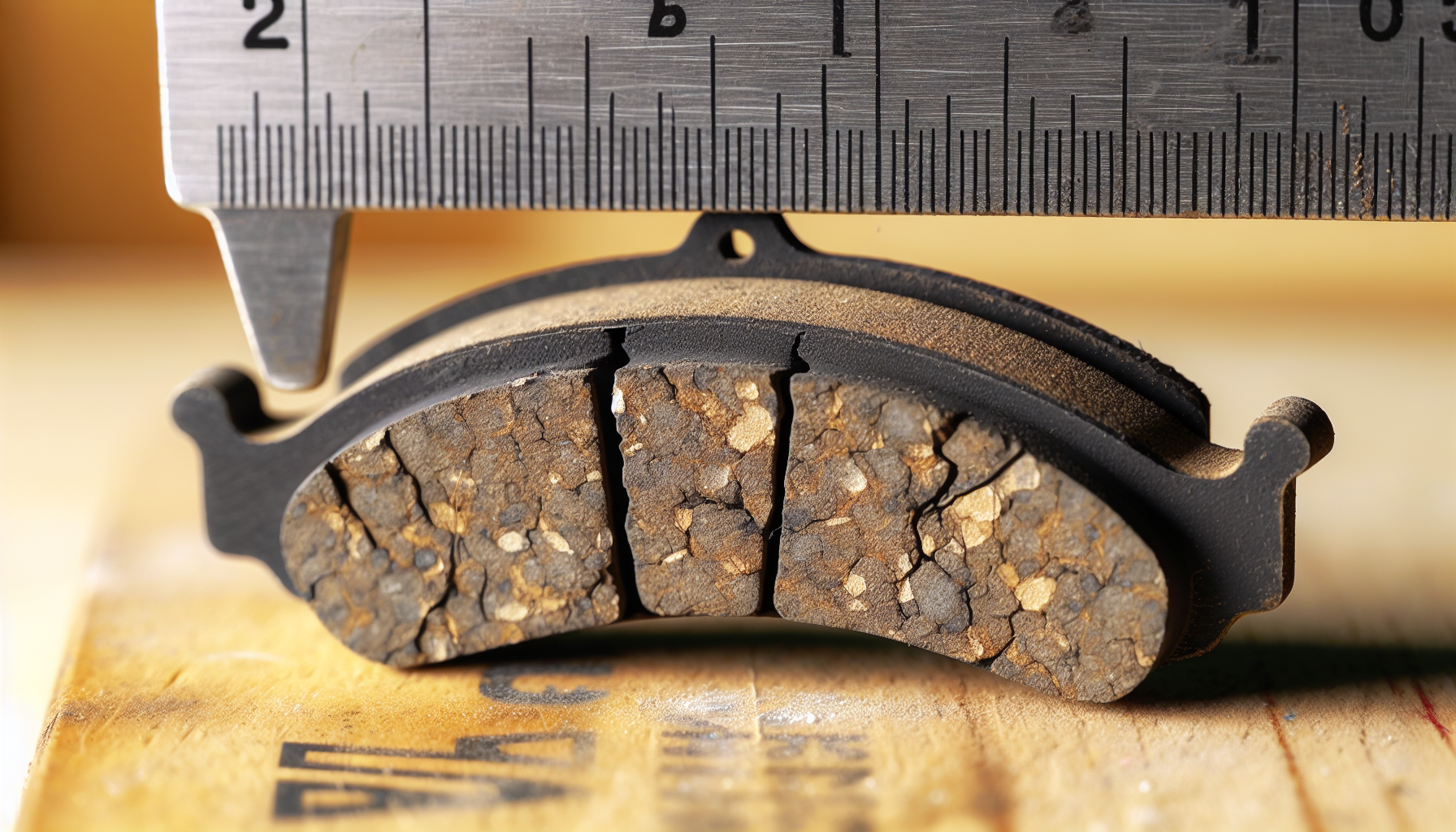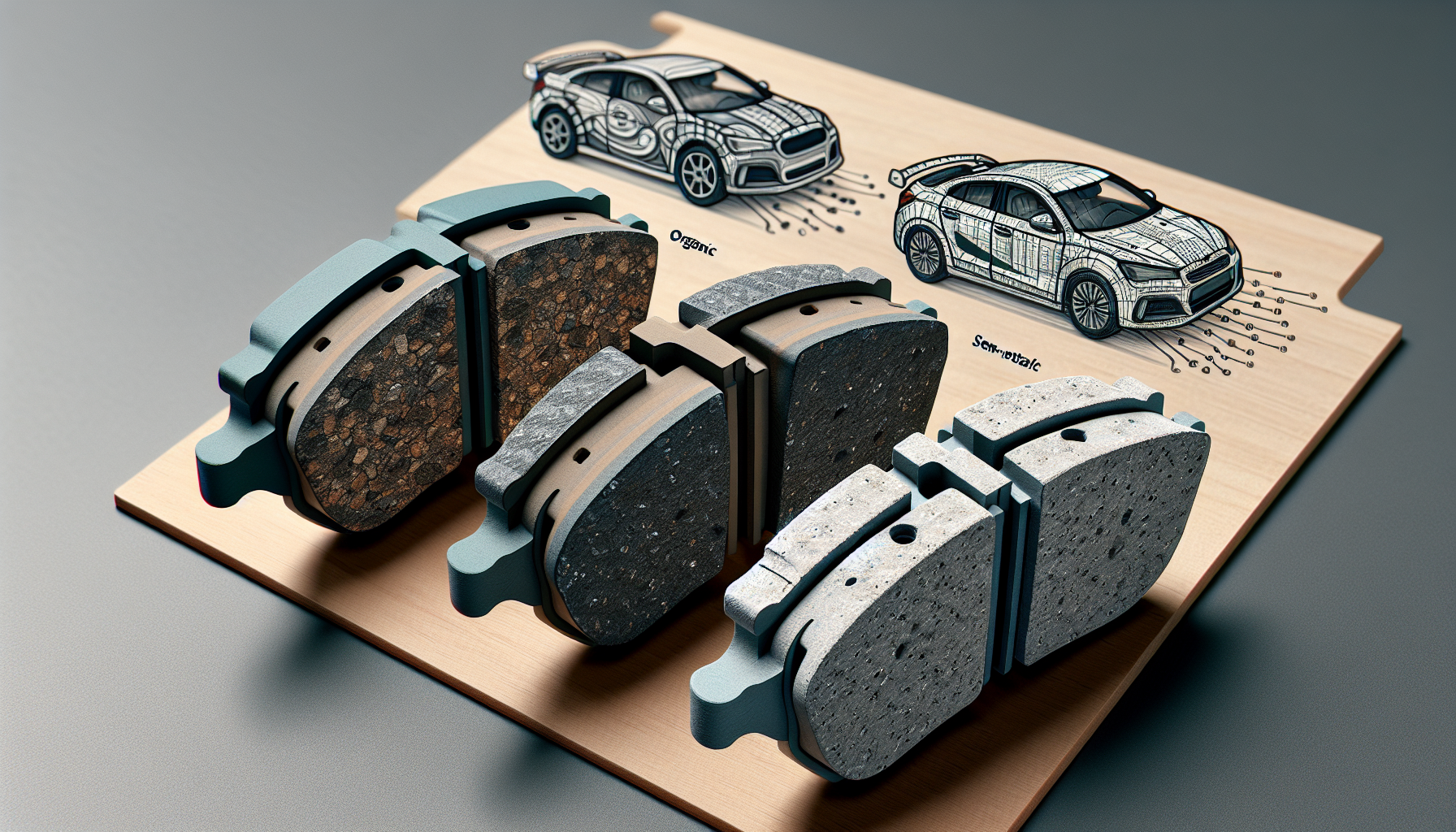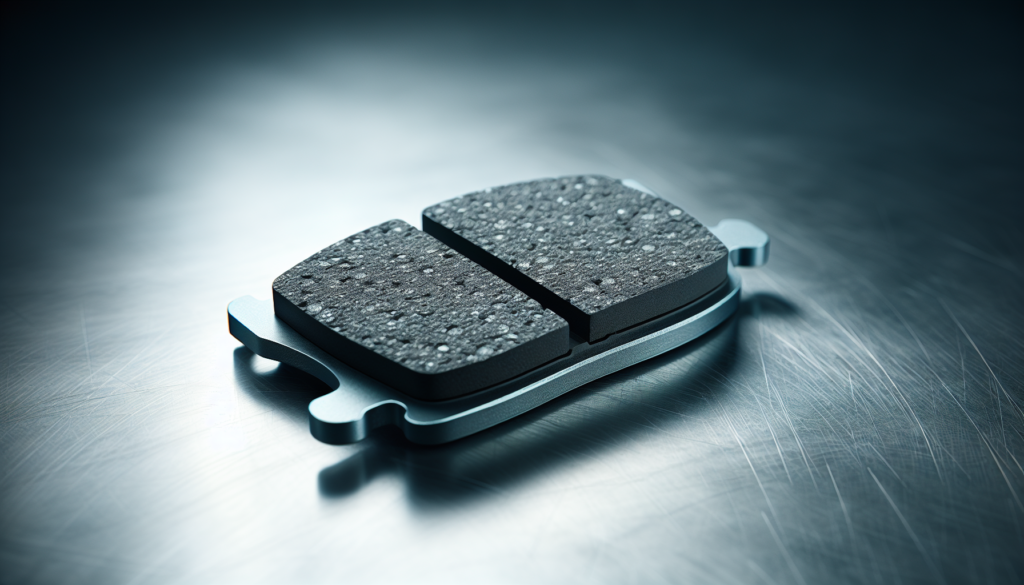Are your brake pads sufficiently thick for a safe stop? New brake pads rest at 10-12 mm, but dropping below 3.2 mm signals a red flag. This article cuts straight to the essentials – from checking brake pad thickness to understanding when to replace them – ensuring you drive with confidence and safety.
Key Takeaways
Brake pads are essential for vehicle safety, with new pads typically 10-12mm thick and 3.2mm deemed the minimum safe thickness for operation.
Brake pad thickness can be checked through visual inspection or with a brake pad gauge, and should be monitored for wear, indicated by noise, warning lights, or uneven performance.
Regular brake pad maintenance and choosing the appropriate material and brand for one’s driving conditions can enhance safety, performance, and cost-effectiveness, with professional inspections recommended every six months.
Understanding Brake Pad Thickness

Brake pads, being a crucial component of your car’s disc brake system, help to slow down or halt your vehicle. They create the necessary friction on the wheel rotor to bring your car to a standstill. However, these essential components wear down over time, and neglecting brake pad thickness can lead to brake pads wear issues such as:
Delayed replacement
Deteriorating braking performance
Longer stopping times
Reduced safety
Maintaining the appropriate brake pad thickness and conducting routine brake pad inspections and maintenance can help avoid such undesirable scenarios. This vigilance ensures that your car’s braking system remains in peak condition, providing you with safe and reliable braking performance whenever you’re on the road.
New Brake Pad Thickness
When it comes to new brake pads, they are designed with a certain thickness level to provide optimal braking performance. On average, most new brake pads boast a thickness ranging between 10 to 12 millimeters.
Yet, the standard thickness might slightly differ based on the brake pad’s type and brand, along with your vehicle’s make and model. Despite these variations, you’ll commonly observe a standard thickness of around 10mm for most new brake pads.
Minimum Brake Pad Thickness

While the thickness of new brake pads is one side of the coin, understanding the minimum brake pad thickness is the other critical side. Mechanics generally agree that the minimum safe thickness for brake pad operation is 3.2 mm.
Operating your vehicle with brake pads thinner than the suggested minimum thickness could jeopardize your braking system and consequently your safety. Therefore, if your brake pads appear thinner than a ¼ inch (6.4 mm) upon visual inspection, it’s high time to replace them to maintain optimal braking function and safety.
How to Check Brake Pad Thickness

So, how do you check brake pads and keep an eye on your brake pad thickness? The process involves either a visual inspection or using a brake pad gauge, and in some cases, both. To prepare for this, follow these steps:
Park your vehicle on a level surface.
Engage the parking brake.
Place wheel chocks.
Use a jack to elevate the vehicle securely with jack stands.
After safely raising and stabilizing your vehicle, you can take off the wheel and visually examine the brake pads to gauge their thickness. However, keep in mind that this is not the only way to inspect your brake pads – there are methods to check brake pad thickness without removing the wheel too.
Visual Inspection
Estimating brake pad thickness is simplest through a visual inspection. Without even removing the wheel, you can look through the holes in the wheel that align with the brake pads. Using a flashlight can give you a better view of the brake pad and help you estimate its thickness.
Another key visual cue is the presence of a metal wear indicator tab on the side of brake pads. If this tab is almost in contact with the rotor or is missing, it suggests that the brake pads are due for replacement. Similarly, if the brake pads look exceptionally thin (less than ¼ inch) or if the wear indicator slot on the pad has almost disappeared, it’s time to check your brake pads for a professional inspection.
Using a Brake Pad Gauge

Using a brake pad gauge can offer a more precise measurement compared to a visual inspection, which provides a rough estimate. You can use this tool without removing the wheel by inserting the tip into the back of the brake pad through the wheel. The gauge will then show you the thickness of the pad in millimeters or inches.
However, note that high-quality brake pad gauges are designed to work on original equipment pads and replacement pads that have an inspection slot in the backing plate. So using a brake pad gauge might not be effective on all types of brake pads.
Recognizing the Signs of Worn Brake Pads
Occasionally, your vehicle will exhibit signs of worn brake pads even before you can measure their thickness. These symptoms can include:
Noises when braking
Brake warning lights
Uneven wear
Your vehicle pulling to one side
Neglecting these symptoms could result in additional damage to your braking system, necessitating immediate professional intervention. For instance, unusual accumulations of brake dust on wheels might be a sign of abnormal brake pad wear, which a professional can detect during an inspection.
Noises When Braking
One of the most noticeable symptoms of worn brake pads is noise when braking. Being attentive to these sounds is vital as they are often early indicators of brake pads that are significantly worn.
A squeaking or squealing noise often signifies that the brake pads have reached the end of their lifespan. This is sometimes indicated by the exposure of a dedicated wear indicator that produces a screeching sound. On the other hand, grinding noises suggest that the pads have worn down to a point where they may be causing damage to the brake rotors, leading to the necessity of more extensive and expensive repairs.
Even deep whooshing or groaning sounds can be a sign of low brake pad thickness, warranting further inspection and likely replacement of the brake pads.
Brake Warning Lights
Another clear sign of worn brake pads is the illumination of brake warning lights on your dashboard. Modern vehicles come equipped with these lights that can indicate low pad thickness and the need for brake system attention.
When the brake pad wear indicator light illuminates, it specifically signals that the brake pads may be worn down to a critical thickness and should be assessed for possible replacement. Moreover, the illumination of the brake warning light can also alert you to other issues within the brake system, such as low brake fluid or problems with the Antilock Braking System (ABS).
Uneven Wear and Vehicle Pulling
Uneven wear of brake pads and your vehicle pulling to one side when braking are other potential signs of brake pad issues. These symptoms can be caused by various issues, such as a sticking caliper piston or slides, indicating possible caliper problems or the need for car alignment.
If your vehicle pulls to one side when braking, it’s crucial to conduct a professional inspection. Such an inspection can pinpoint and address issues within the brake pads or the entire brake system, preventing further damage and ensuring your safety on the road.
Brake Pad Materials and Their Impact on Thickness

Your brake pads’ friction material significantly influences their thickness, performance, and rates of wear. Brake pads can be categorized into three primary types – organic, semi-metallic, and ceramic, each with distinct characteristics suitable for different driving conditions and vehicles.
Organic brake pads, including rear pads, are known for being quieter and producing less dust but typically experience pads wear more quickly than other types, such as thin brake pads, making them an appropriate choice for standard everyday driving and commuting.
Ceramic brake pads offer durability and consistent performance across various temperatures with minimal noise and dust, thereby adapting well to urban commuting and general-purpose driving.
Semi-metallic brake pads are designed with a high metal content for improved braking performance and heat conductivity, making them suitable for high-performance and heavy vehicles, though they tend to be noisier and generate more dust.
The Importance of Regular Brake Pad Maintenance
Maintaining your brake pads regularly is key to your vehicle’s safety. It’s recommended to check brake pad thickness every five months or 5,000 miles to prevent brake failure and maintain optimal vehicle safety. Ensuring functional brakes through regular maintenance is vital for avoiding dangerous situations on the road, including brake failure and potential accidents.
Timely replacement of brake pads before they completely wear out can save you money by preventing the need for more expensive repairs, such as rotor replacements. Additionally, frequent inspections of brake pads can prevent stress on other brake components, thereby avoiding more costly repairs down the line. Thus, regular brake pad maintenance not only ensures your safety but also contributes to cost-effectiveness.
Tips for Choosing the Right Brake Pads for Your Vehicle
Selecting the appropriate brake pads for your vehicle can be a complex task. It involves considering your regular driving conditions, such as stop-and-go traffic or heavy towing, and consulting your vehicle’s owner’s manual for recommended brake pad specifications.
Opt for reputable brake pad brands and consider the material’s impact on noise, dust, and rotor wear to ensure reliability and your personal drive comfort preferences. While price is a consideration, it’s essential to find a balance between cost, quality, and the safety and performance requirements of your driving conditions.
For additional guidance on the most appropriate brake pads for your vehicle and driving habits, don’t hesitate to consult with a trusted mechanic to replace brake pads and ensure proper brake pad replacement.
Professional Brake Pad Inspection and Replacement
Though routine self-inspections are beneficial, signs of brake pad problems may not always be readily apparent. In such cases, it is recommended to have a professional look at the car for brake system inspection, especially if there is a low brake pedal or brake fluid leak.
Professional inspections should be conducted at least every six months or during routine tire rotations. Additionally, brake fluid, which is essential for proper brake system functioning, should be evaluated and changed by a professional at recommended intervals.
Summary
In summary, understanding brake pad thickness, recognizing signs of worn brake pads, and conducting regular maintenance are key to ensuring your vehicle’s braking system’s optimal performance. Regardless of your driving conditions or the type of vehicle you drive, keeping an eye on your brake pads can greatly contribute to your safety on the road. Remember, the cost of regular maintenance is small compared to the cost of an accident due to brake failure.
Frequently Asked Questions
Is 4 mm brake pads OK?
Brake pads are generally recommended to be replaced when they wear down to 3mm, so 4mm thickness is still acceptable. However, it’s advisable to keep an eye on your brake pads and replace them if they start to generate a squeaking sound.
Is 5 mm on brake pads OK?
Brake pads with 5mm thickness are still within the acceptable range for use. It’s recommended to follow the manufacturer’s minimum lining thickness of 2mm.
What is the standard thickness of new brake pads?
The standard thickness of new brake pads usually ranges from 10 to 12 millimeters.
What is the minimum safe thickness for brake pads?
The minimum safe thickness for brake pad operation is considered to be 3.2 mm. It is important to replace brake pads once they reach this thickness to ensure optimal safety.
How do I check my brake pad thickness?
You can check your brake pad thickness through a visual inspection or by using a brake pad gauge. Make sure to inspect them regularly for safe driving.
